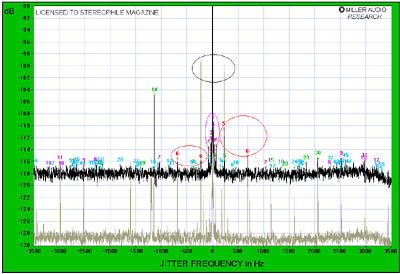I have been meaning to comment on this but keep forgetting. Besides Jude, Bob Smith (atomicbob) has been posting measurements. Wanted to point this flaw in his jitter measurement methodology which he keeps using on everything he tests. Here it is on Yggy V2:
View attachment 13587
If you can read that, you have eaten far more carrots than I have

. So let's pull that into photoshop and making more legible:
View attachment 13586
As we see, his graph starts at 7.5 kHz and ends at 14.5 kHz. Why? We need to see full bandwidth of audio.
As I noted there, cutting off low frequencies means we don't see power supply contributions although we can infer it from the sidebands around his main tone as I show in my measurements:
I routinely see power supply issues in DACs I measure and not showing the spectrum down to 20 Hz is a definite mistake.
While there is not much of interest in higher frequencies here, nevertheless the graph needs to show that so that we can tell. Many DACs have garbage at higher frequencies induced by front panel displays, other periodic events running inside the DAC, etc.
When told about this issue, he posts more charges addressing something different and finishes with this:
View attachment 13588
Well, the coverage of jitter measurements in AES17 are quite brief. Instead reader is sent to another AES standard:
View attachment 13589
In there, we find this:
View attachment 13590
So clearly they are interested to see jitter contributions from far wider bandwidth than Bob uses.
Yes, JA at stereophile also makes the same mistake.
Summary
Bob's Jitter measurements are incomplete. They show the least interesting range of frequencies which is around our perceptual masking tone. Jitter spectrum should include full audible bandwidth.

